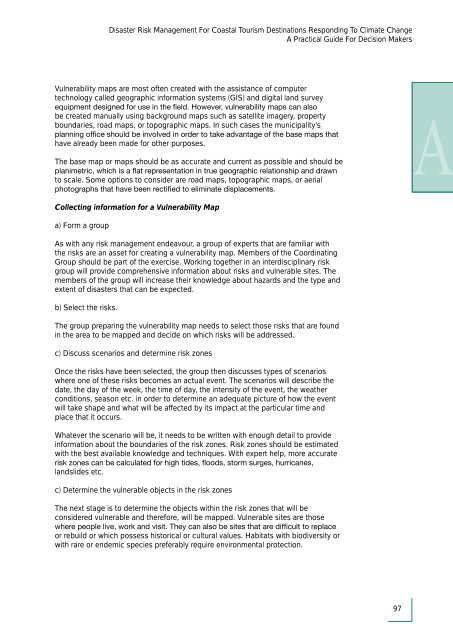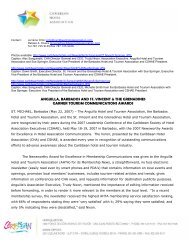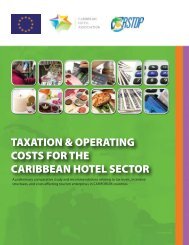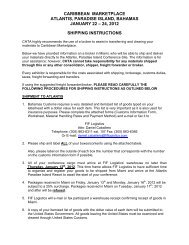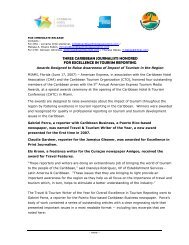Disaster Risk Management for Coastal Tourism - Caribbean Hotel ...
Disaster Risk Management for Coastal Tourism - Caribbean Hotel ...
Disaster Risk Management for Coastal Tourism - Caribbean Hotel ...
You also want an ePaper? Increase the reach of your titles
YUMPU automatically turns print PDFs into web optimized ePapers that Google loves.
<strong>Disaster</strong> <strong>Risk</strong> <strong>Management</strong> For <strong>Coastal</strong> <strong>Tourism</strong> Destinations Responding To Climate Change<br />
A Practical Guide For Decision Makers<br />
Vulnerability maps are most often created with the assistance of computer<br />
technology called geographic in<strong>for</strong>mation systems (GIS) and digital land survey<br />
<br />
be created manually using background maps such as satellite imagery, property<br />
boundaries, road maps, or topographic maps. In such cases the municipality’s<br />
<br />
have already been made <strong>for</strong> other purposes.<br />
The base map or maps should be as accurate and current as possible and should be<br />
<br />
to scale. Some options to consider are road maps, topographic maps, or aerial<br />
<br />
A<br />
Collecting in<strong>for</strong>mation <strong>for</strong> a Vulnerability Map<br />
a) Form a group<br />
As with any risk management endeavour, a group of experts that are familiar with<br />
the risks are an asset <strong>for</strong> creating a vulnerability map. Members of the Coordinating<br />
Group should be part of the exercise. Working together in an interdisciplinary risk<br />
group will provide comprehensive in<strong>for</strong>mation about risks and vulnerable sites. The<br />
members of the group will increase their knowledge about hazards and the type and<br />
extent of disasters that can be expected.<br />
b) Select the risks.<br />
The group preparing the vulnerability map needs to select those risks that are found<br />
in the area to be mapped and decide on which risks will be addressed.<br />
c) Discuss scenarios and determine risk zones<br />
Once the risks have been selected, the group then discusses types of scenarios<br />
where one of these risks becomes an actual event. The scenarios will describe the<br />
date, the day of the week, the time of day, the intensity of the event, the weather<br />
conditions, season etc. in order to determine an adequate picture of how the event<br />
will take shape and what will be affected by its impact at the particular time and<br />
place that it occurs.<br />
Whatever the scenario will be, it needs to be written with enough detail to provide<br />
in<strong>for</strong>mation about the boundaries of the risk zones. <strong>Risk</strong> zones should be estimated<br />
with the best available knowledge and techniques. With expert help, more accurate<br />
<br />
landslides etc.<br />
c) Determine the vulnerable objects in the risk zones<br />
The next stage is to determine the objects within the risk zones that will be<br />
considered vulnerable and there<strong>for</strong>e, will be mapped. Vulnerable sites are those<br />
<br />
or rebuild or which possess historical or cultural values. Habitats with biodiversity or<br />
with rare or endemic species preferably require environmental protection.<br />
97


